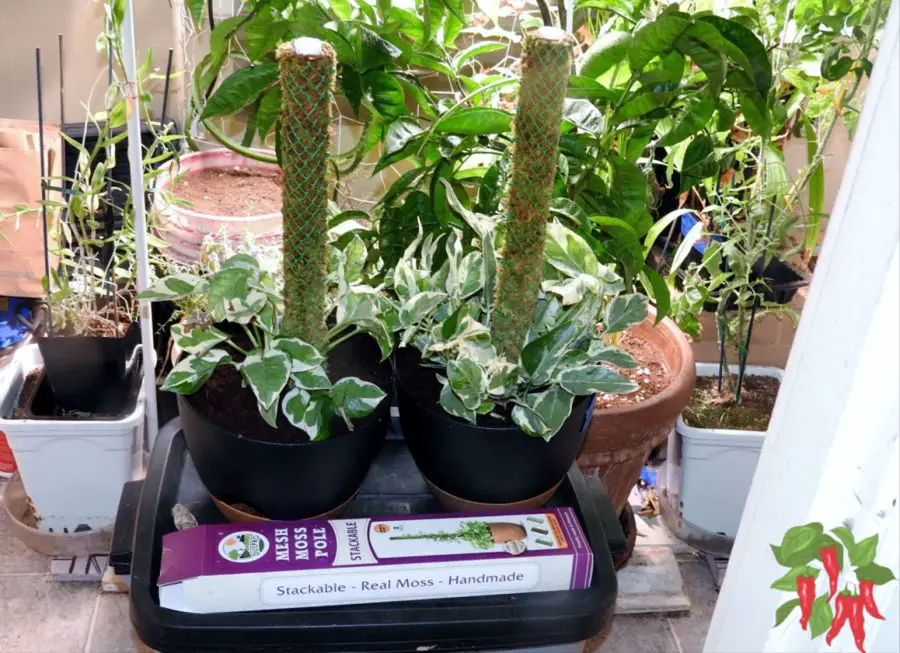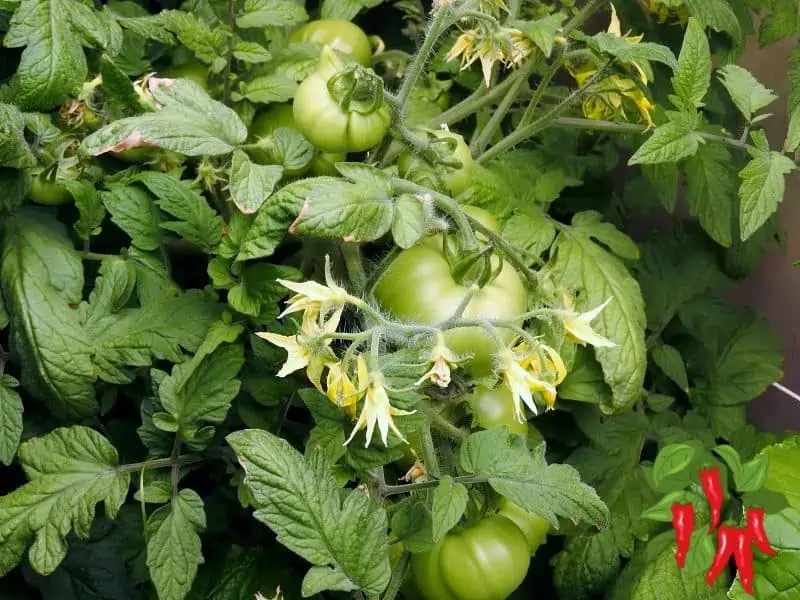This post may contain affiliate links. If you buy something from one of our links we may earn a commission. Thanks

Ever wondered how to use a moss pole to take your houseplants to new heights? If your climbing plants are looking a bit lost and directionless, a moss pole might be just the ticket.
These nifty plant supports not only give your green friends something to cling to, but they can also help your plants grow bigger, healthier leaves. Let’s dive into the world of moss poles and turn your indoor jungle into a vertical paradise!
How To Use a Moss Pole Key Takeaways
- Here’s how to use a moss pole:
- Insert the pole into your plant’s pot, positioning it near the stems.
- Gently guide the plant’s vines towards the pole and secure them with soft ties.
- Keep the moss moist by misting regularly to encourage root growth.
- This support helps climbing plants grow upwards, resulting in larger, healthier leaves.
- Growing vertically also saves floor space.
What is a Moss Pole?
A moss pole is a support structure designed for climbing plants. It’s typically made of a sturdy central core wrapped in moss or a moss-like material. Some popular types include:
1. Real moss poles (filled with sphagnum moss)
2. Coco coir poles
3. Synthetic moss poles
For this guide, we’ll focus on a real moss pole, which tends to hold moisture better and looks more natural.
Why Use a Moss Pole?
 DUSPRO 2Pack 38” Green Stackable Mesh Moss Pole for Plants Climbing Vines Supporting Monstera
DUSPRO 2Pack 38” Green Stackable Mesh Moss Pole for Plants Climbing Vines Supporting Monstera
Moss poles offer several benefits for climbing plants like pothos, philodendrons, and monsteras:
1. They provide support for vertical growth.
2. They encourage the development of larger, healthier leaves.
3. They allow plants to grow more naturally, as they would in their native habitats.
4. They can help maintain a neat, organized appearance in your plant collection.
How to Install a Moss Pole
1. Choose the right size pole for your plant and pot.
2. If your pole comes in separate pieces, assemble it according to the manufacturer’s instructions.
3. For larger plants, gently dig around in the pot to find a spot with fewer stems.
4. Insert the pole into the soil, ensuring it’s stable and upright.
5. For smaller plants, you can place the pole near the edge of the pot or right next to the plant.
Attaching Your Plant to the Moss Pole
1. Wait until your plant has developed some length in its vines.
2. Look for aerial roots on your plant – these are a sign that it’s ready to climb.
3. Gently guide the plant’s vines towards the pole.
4. Use soft plant ties or twine to loosely secure the vines to the pole.
5. Be patient – it may take time for your plant to start climbing on its own.
Maintaining Moisture in Your Moss Pole
Keeping your moss pole moist is crucial for encouraging root growth into the pole. Here are some tips:
1. Soak the pole before installation if possible.
2. Use a fine mister or spray bottle to regularly moisten the pole.
3. Avoid pouring water directly onto the top of the pole, as it tends to run off.
4. Consider using a Solo Mister for a fine, even spray.
 SOLO 418 2 Liter One-Hand Pressure Sprayer, Red and White
SOLO 418 2 Liter One-Hand Pressure Sprayer, Red and White
Pros and Cons of Different Pole Types
Mosser Lee ML1010H Totem Pole Plant Support, 24″,Brown
1. Real Moss Poles:
- Pro: Hold moisture well
- Pro: Look natural and blend with plants
- Con: May be more expensive
 Moss Pole Monstera Plant Support Stakes – 2×26.4 or 48.7″ Unique Self-Watering, Extendable Coco Coir Pole for Climbing Plant Supports for Potted Plants Indoor, Totem Pole for Monstera, Pothos & More
Moss Pole Monstera Plant Support Stakes – 2×26.4 or 48.7″ Unique Self-Watering, Extendable Coco Coir Pole for Climbing Plant Supports for Potted Plants Indoor, Totem Pole for Monstera, Pothos & More
2. Coco Coir Poles:
- Pro: Affordable and widely available
- Con: May not hold moisture as well as real moss
Remember, while moss poles are great for many climbing plants, they’re not absolutely necessary. Plants like pothos can trail beautifully without support.
However, using a moss pole can lead to larger leaves and a more upright growth habit, which many plant enthusiasts prefer.
Choosing the Right Moss Pole for Your Plant
Picking the perfect moss pole for your plant is like finding the right dance partner – it’s all about compatibility and size!
First, consider the mature size of your plant. A small pothos might be happy with a 2-foot pole, but a monstera could need a 6-foot giant.
Look at the thickness too – larger plants need sturdier support.
Material matters as well. Real sphagnum moss poles are great for moisture retention, but coco coir can be a more sustainable option.
Some poles come with extendable sections, which is handy as your plant grows. Whatever you choose, make sure it’s securely anchored and tall enough to support future growth.
Remember, it’s easier to start with a larger pole than to upgrade later!
DIY Moss Pole: Make Your Own at Home
Feeling crafty? Making your own moss pole can be a fun weekend project! Start with a sturdy central support – PVC pipe works great.
Wrap it in chicken wire, leaving a bit of overhang at the top. Then, stuff the wire cage with dampened sphagnum moss, packing it tightly as you go.
For a finishing touch, you can wrap the outside with fishing line or jute twine to keep everything snug.
The best part of DIY? You can customize the size and shape to perfectly fit your plant and space.
Plus, it’s usually cheaper than store-bought options. Just be sure to use materials that can stand up to constant moisture without rotting or rusting. Happy crafting!
Troubleshooting Common Moss Pole Problems
Even with the best care, you might run into a few hiccups with your moss pole.
One common issue is dryness – if your pole isn’t retaining moisture, try misting more frequently.
If you notice mold growth, improve air circulation around your plant and cut back on watering a bit.
Sometimes, plants can be stubborn about climbing. In this case, patience is key. Keep guiding new growth towards the pole and ensure the moss is consistently moist to encourage those aerial roots.
If your plant seems to be outgrowing its pole, don’t panic! You can often add extensions to existing poles or gradually transition to a larger one.
Remember, every plant is unique, so don’t be afraid to adjust your approach until you find what works best.
Best Plants for Moss Pole Growing
While many plants can benefit from a moss pole, some are absolute superstars at climbing.
Monsteras are probably the most famous moss pole lovers – they’ll reward you with huge, dramatic leaves as they climb.
Pothos and philodendrons are also excellent choices, with their quick growth and abundant aerial roots.
For something a bit different, try a climbing hoya. These waxy-leaved beauties can create stunning cascades of flowers when given proper support.
Aroids like Syngonium and Epipremnum pinnatum are also fantastic climbers that develop more mature, impressive leaves when allowed to grow upwards. Even some ferns, like the rabbit’s foot fern, can be trained up a moss pole for a unique, textural display. The key is to choose plants with a natural climbing or vining habit – they’ll be the happiest on your moss pole!
How To Use a Moss Pole FAQs
Got questions about using moss poles? You’re not alone! Here are some common queries we often hear from plant parents:
Q. What plants can grow on moss poles?
A. Many climbing plants thrive on moss poles, including pothos, philodendrons, monsteras, hoyas, and various species of aroids. Essentially, any plant with aerial roots or a climbing habit can benefit from a moss pole.
Q. How do you get a plant to climb a pole?
A. Guide the plant’s vines towards the pole and secure them with soft ties. Keep the moss moist to encourage aerial root growth. Be patient and consistent – your plant will learn to climb over time.
Q. How do you train aerial roots to moss pole?
A. Gently guide aerial roots towards the moist moss. You can lightly mist the pole to keep it damp, which will encourage the roots to grow into the moss naturally.
Q. Should I wrap aerial roots around moss pole?
A. It’s better to let the aerial roots attach naturally. Gently guide them towards the pole, but avoid forcefully wrapping them as this could damage the roots.
Q. Do plants root into moss poles?
A. Yes, many climbing plants will grow aerial roots into a moist moss pole. This mimics their natural growing conditions and helps support the plant.
Q. Do you have to soak a moss pole?
A. While not mandatory, soaking a new moss pole before use can help ensure it’s thoroughly moist. After that, regular misting is usually sufficient.
Q. How to train a plant to grow on a moss pole?
A. Regularly guide new growth towards the pole, securing it gently with soft ties. Keep the moss moist and be patient – it can take time for a plant to start climbing on its own.
Q. Does Monstera really need a moss pole?
A. While not strictly necessary, a moss pole can greatly benefit a monstera. It provides support for larger leaves and encourages the plant to grow in its natural, climbing manner.
Q. How do I get my plants to stick to my moss pole?
A. Keep the moss pole consistently moist to encourage aerial root growth. Guide the plant’s stems towards the pole and secure them loosely. Over time, the plant will naturally attach itself.
Q. How do you introduce a moss pole?
A. Insert the pole into the pot, ensuring it’s stable. Gradually guide your plant’s vines towards the pole, securing them gently. Be patient as your plant adjusts to its new support.
Q. Do you mist a moss pole?
A. Yes, regular misting helps keep the moss pole moist, which encourages aerial root growth and helps your plant attach to the pole.
Q. How long does a moss pole last?
A. With proper care, a good quality moss pole can last several years. However, as your plant grows, you may need to upgrade to a larger pole to provide adequate support.
Remember, every plant is unique, so don’t worry if yours takes a little time to adapt to its new moss pole. With patience and care, your climbing plants will soon be reaching new heights!
How To Use a Moss Pole Conclusion
A Guide for Happy, Climbing Houseplants
If you’re looking to encourage your climbing houseplants to reach new heights, a moss pole might be just what you need.
These handy plant supports not only provide structure for your plants but also promote healthier growth and larger leaves. Let’s dive into how to use a moss pole effectively.
Wrapping Up Your Moss Pole Adventure
Now that you’re armed with the knowledge of how to use a moss pole, you’re ready to give your climbing plants the boost they need.
Remember, using a moss pole isn’t just about making your plants look prettier – it’s about helping them grow in a way that’s more natural and beneficial for them.
Read more: Duspro Green Stackable Mesh Moss Pole Review – Stay Green Garden
Moss Pole Key Takeaways:
• Moss poles provide support and encourage healthier growth in climbing plants
• Install the pole carefully, considering your plant’s size and pot space
• Keep the moss moist to promote aerial root growth
• Be patient – it may take time for your plant to start climbing
• Regular maintenance, including misting and gentle guidance, will help your plant thrive
With these tips in your gardening toolkit, you’re all set to create a stunning vertical garden indoors. Happy planting, and may your houseplants reach new heights!
Visit my Amazon Influencer Page for videos and gardening products Grow Your Own Garden







